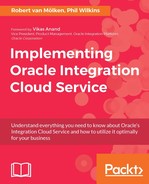In this chapter, we looked at the social integration capabilities that ICS provides out-of-the box. We integrated with Twitter in our first integration and with Google in our second integration.
In the integration with Twitter, we set up a new application on Twitter that uses the assigned account to post tweets by creating the application and creating the necessary API credentials. With these credentials we created a connection from ICS to Twitter by configuring the API credentials to use.
The inbound connection of the integration used a WSDL with multiple operations, which we used for both the Twitter and the Google integration. For the Twitter integration, the FlightScheduleUpate operation was used.
In the integration, we showed that, based on the incoming request message, we constructed a dynamic message, a tweet, and sent it to Twitter. In the request mapping, we constructed the tweet dynamically using XSL elements such as choose, when, and otherwise.
After finishing the integration, we tested with five different request messages and showed that the tweets were posting on our timeline. We concluded by looking at troubleshooting.
In the second integration, with Google, we showed how to set up a new project in the Google developer console, create the necessary credentials, and enable the Gmail API in the API Manager. With the credentials, we created the connection from ICS to Google Mail by configuring the API credentials, but also by providing the required security scope and giving consent to ICS to interact with the API.
The integration used the same WSDL, but in this case the MissingPersonReport operation was used. In the integration, we showed how the export and import functionality of the XSL mapper works, but also how to reuse an existing XSL template.
The XSL mapping constructed a MIME e-mail format based on the values in the request message. This message was then sent through the Gmail API.
After finishing the integration, we tested with one request, which sent an e-mail from the assigned account to the defined receiver. We concluded this integration by also looking at troubleshooting.
In the next chapter, and the third part of the book, we are going to go a step further and look at creating more complex transformations. We are going to incorporate an enrichment service and see how we can exploit the additional variables that hold the data. In this chapter, we will also look at the concepts of lookups to substitute domain values.
